Basketball Offense - Pete Carril's Princeton Offense
By Dr. James Gels, From the Coach’s Clipboard Basketball Playbook"Helping coaches coach better..."
Disclosure: This page contains affiliate links, which means that Coach's Clipboard receives a small commission (at no cost to you) if you make a purchase using these links.
The Princeton offense was created by Pete Carril at Princeton some years ago. This article presents Coach Carril's Princeton offense. For more details, get the Princeton Offense 2-DVD set. Also see this simplified discussion of the Princeton offense.

Coach Pete Carril
They must possess some "basketball sense" or IQ in order to read the actions of teammates and of the defense, as this is a free-lance offense, rather than a set pattern. The offense breaks down into a series of 3-man plays, with some 1-on-1 play also possible.
Players are always trying to help each other get a good shot with screening, cutting, passing and spacing. The back-door cut is a hallmark of the Princeton offense. Having a center who can play away from the basket at the high post and shoot effectively from there, and can handle the ball, and can pass well (the "hub" of the offense) is a real bonus in running the Princeton offense.
Coach Carril discusses three basic "sets" - the "Low-Post Offense", "High-Post Offense", and the "Chin Series", and how to flow from one set to another.
Princeton Low-Post Offense
The basic Princeton set (diagram A) has two guards (O1 and O2), two forwards (O3 and O4 - free-throw line extended), and the center (O5), who plays either low or high. As the title "low-post offense" suggests, here the center (O5) initially starts inside on the low block. O1 passes to O2 (diagram LPA). O2 passes to O3 and cuts through looking for the pass from O3 - cutters always have their hands ready, looking to get the pass inside. O2 cuts out to the opposite corner. O3 passes to O5 in the low post.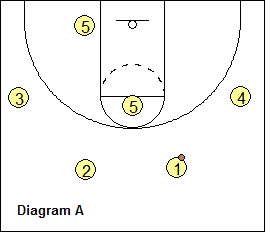

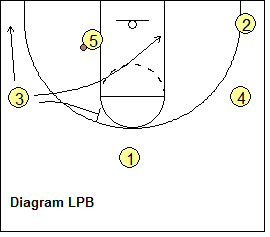
Diagram LPB shows that the forward O3 has three options after passing into the post: (1) move down to the corner, (2) Laker cut inside around the post player, or (3) screen for the guard O1.
The first Princeton principle is "watch the man in front of you - he will tell you where to go." O1 sees the screen coming and cuts around O3's screen (diagram LPC) and could get the pass from O5 for a jump-shot. O1 may not be open for a shot, and passes back up top to O3 who pops out after screening (diagram LPD), and O3 may have a 3-point shot. Or O5 may pass directly to O3 for the 3-point shot (diagram LPE).
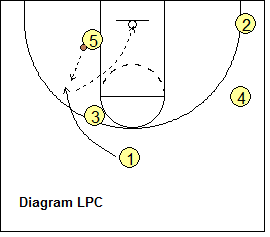


Now let's back-track to O3's screen for O1. Diagram LPF shows the X1 defender impeding O1 from cutting over the screen, so instead, O1 cuts back-door to the hoop for a pass from O5. This highlights the second Princeton principle, "when you are closely-guarded, cut back-door." After O1 back-cuts, O3 pops out on top for the pass from O5 (diagram LPG).

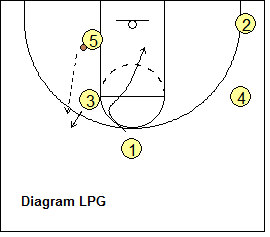
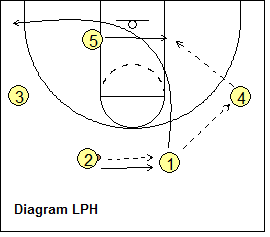
Getting into the Offense
Diagram LPH. On a pass to the wing, the passer cuts through to the opposite corner. Here O2 passes to O1. O1 passes to the forward O4 on the wing, and O1 cuts through, looking for a return pass, and then out to the left corner. The center O5 moves to the ballside low block, and O4 passes inside to the low-post O5. O4 has those three options on passing to the post: slide to the corner, Laker cut inside, or screen for the guard. Diagram LPI shows the forward-to-guard screen option with O4 screening for O2, and O5 could pass to O2.
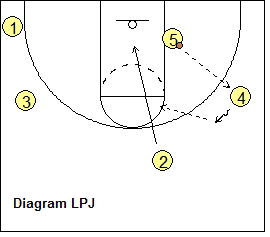
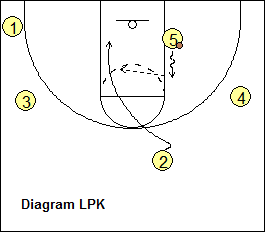
Alternately, O5 might pass back out to O4 (diagram LPJ). O4 might dribble up top toward O2. Whenever we have a "dribble-at" situation, we back-door cut, so O2 back-cuts through and might get a pass from O4. Or, O5 might take a couple dribbles up the lane line and pass to O2 back-cutting through (diagram LPK).
Going Cross-Court
In diagram LPL, O5 has the ball in the low post, and the forward O3 screens for the guard O1, who decides to cut back-door to the hoop. This cut often causes O2's and O4's defenders to drop into the paint to give help on the cutter, and now O5 can skip pass out to either O2 or O4 for a 3-point shot.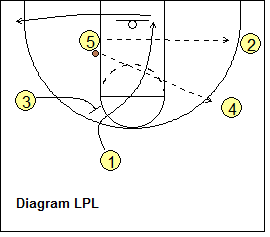

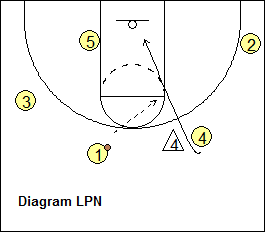
Another way of going cross-court is to swing the ball from the guard O1 to the opposite guard O4 on the top (diagram LPM). Now O4 could shoot the 3-point shot, or attack with the dribble-drive for a lay-up, pull-up jump-shot, or a kick-out pass to O2 for a shot. If the guard-to-guard pass is being denied, O4 cuts back-door (diagram LPN).
Passer Screens for the Center
In diagram LPO, O1 passes to O4 and then down-screens for the center O5, and O5 cuts up to the arc and could get a reverse pass back from O4 (diagram LPP). The center O5 then power-dribbles toward the forward O3 (diagram LPQ), and O3 comes around and gets a hand-off and screen from O5. O3 could have an open shot here.
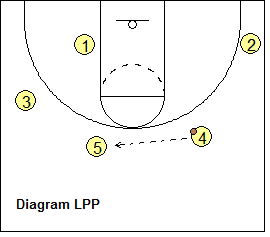

Or, the defense might jump-switch the hand-off and O5 slips the screen inside (diagram LPR). O1 pops out and O3 might pass to O1, and O1 could then look to pass into the center in the low post. Alternately, after dribbling around the hand-off screen, O3 might pass to O4 on a back-door cut (diagram LPS) if the X4 defender is denying the pass.
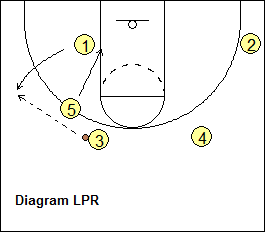
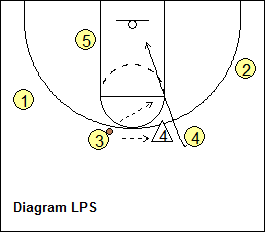
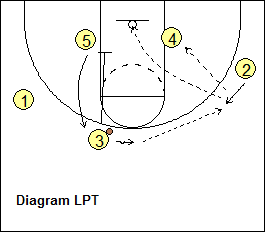
Even if the back-door cut is not open, this action will then allow the wing O2 to be wide open for the next pass (diagram LPT), as O2's defender will usually drop inside briefly to help on the back-door cutter. This emphasizes that every little action executed correctly is important... here the back-cut creates the open pass for O2. Now O2 can shoot or look to pass to O4 in the low post, as O3 down-screens for O5.
Get the rest of the Princeton Low-Post Offense in the Premium Members section and the Playbook download.
It also includes all of these important parts of the Princeton Low-Post Offense:
- Going to a One-Guard Front.
- Guard's three options after passing into the high-post.
- Screen-Away options.
- Guard's three options after receiving the screen-away.
- Screen-Toward the Ball options ("scissors" action).
- Two additional options when passing into the high-post.
This concludes the low post offense and all it's many options. Next we'll discuss the high-post offense.
Princeton High-Post Offense
Why use a high-post instead of a low-post offense?
- Using the high post spreads the defense and opens up the area below the free-throw line for cutting and attacking with the dribble-drive.
- The opponents "big" defenders may not be comfortable defending away from the basket and might lack the quickness that our players have.
- It's easier to reverse the ball from side to side with a high post player, and a high-post player helps relieve defensive pressure on our perimeter players.
Of course, it's very helpful if the center O5 possesses some dribbling and passing skills, and can step out and shoot the outside shot.
"Turn-Out" - Wing Pass Entry
We start with the Princeton 2-3 high set (diagram HP1), and O1 starts the offense by passing to the wing-forward O4. Both guards then cut inside and stop just below the blocks. O5 steps out to receive the pass from O4 (diagram HP2). The forwards O4 and O3 then downscreen for O1 and O2. The guards O1 and O2 criss-cross underneath and come around the downscreens and cut out to the wings. O5 passes to O2 for a possible 3-point shot (diagram HP3).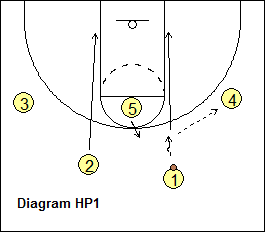
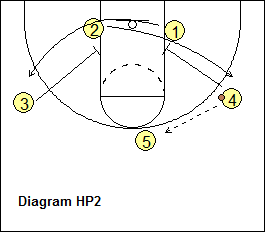

As the pass goes to O2 on the wing, O1 cuts back down low (diagram HP4), and O3 and O5 set a double, staggered down-screen for O1. O1 cuts around the screens and could get the pass from O2 and a shot (diagram HP5). After screening, the center O5 goes to the low block, and the forward O3 moves to the left wing.
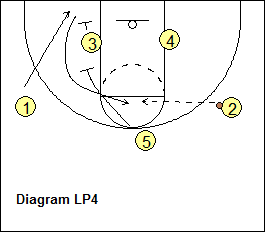
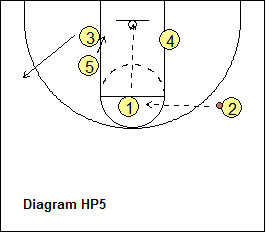
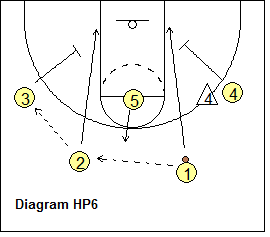
"Turn-Out" - Wing Entry Pass is Denied
If the original pass to O4 on the wing is denied (diagram HP6), O1 can start the offense by passing across to the opposite guard O2, and now we just run the offense on the left side. O2 passes to the forward-wing O3, both guards cut inside to the low blocks and will receive the downscreens from the wings as O5 steps out on top to get the pass from O3. Now everything is the same as before."Turn-Out" - Wing Entry Pass and Guard Entry Pass are Both Denied
Diagram HP7 shows that the pass to the wing O4 and the pass to the opposite guard O2 are both denied. Here, O1 "waves" O2 through and O2 cuts through to the low block, as O5 steps out to get the pass from O1. Now O1 cuts to the other low block, and again, everything is the same as discussed before... the guards will receive downscreens from the forwards O3 and O4 (diagram HP8), and criss-cross and cut around the screens.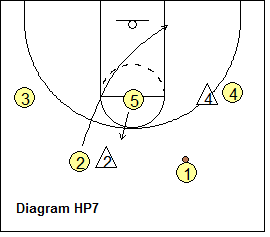

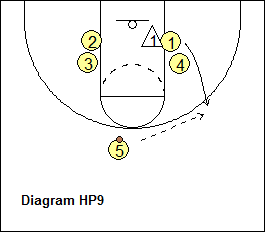
Get the rest of the Princeton High-Post Offense in the Premium Members section and the Playbook download.
It also includes all of these important parts of the Princeton High-Post Offense:
- Guards' three options when using the down-screens.
- "Turn-Out" - Dribble Entry.
- The Center Pops Out.
- Going from High-Post to Low-Post Offense.
- Back-door Cuts.
- Center can Dribble Hand-Off.
- Sagging Defenses and Powerful Opponents.
Princeton "Chin" Series
We again start with the Princeton 2-3 high set.Shuffle Cut
We start by swinging the ball (diagram C1). The guard with the ball (O1) passes to the opposite guard (O2), and O2 passes to the wing-forward O3. The center O5 steps out to the arc and back-screens for O1, and O1 makes the "shuffle" cut (a back-sided cut) around the screen to the ballside corner. O1 might get a pass from O3 and a lay-up.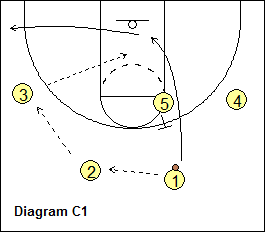
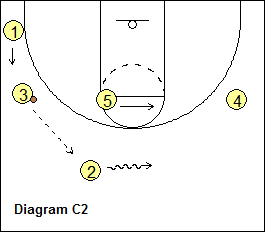
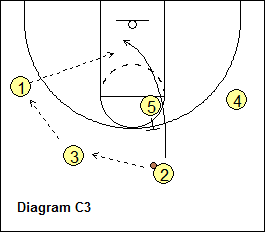
Pass to the shuffle cutter is denied.
The center O5 always "goes with the dribble". After screening for O1, O5 cuts to the ballside elbow (diagram C2). When the pass to O1 is not open, the forward O3 passes back to guard O2. O2 dribbles over to the right, and O5 follows him to the right elbow. Now we run the same shuffle cut with O2 (diagram C3), by swinging the ball again to the left wing, and O5 back-screening for O2.Pass from wing to guard is denied.
In diagram C4, the pass from O1 to O3 is denied, so O1 simply dribbles back to the top. This dribble-at triggers O3 to back-cut through to the opposite block and then wing, as O4 rotates up to the right guard spot. Now we run the shuffle cut again, first by swinging the ball to O3 at the right wing (diagram C5), and then O5 back-screens for O1, who makes the shuffle cut from the left side.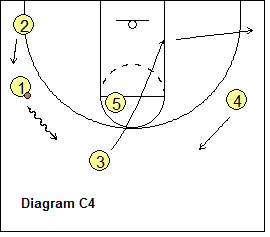
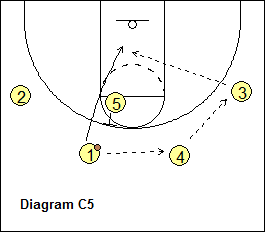
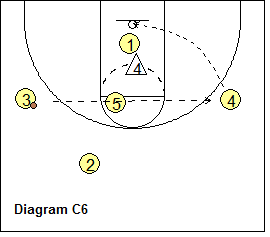
Skip-pass to opposite wing.
Now let's back-track to the first time through on the shuffle series (diagram C6). O3 has the ball on the wing after it was swung from O1 to O2 and then to O3. O1 has made the shuffle cut. If the X4 defender drops inside in help position, O3 might skip pass to O4 for a 3-point shot.Center turns and drives to the hoop.
Instead, O3 passes to the center O5 (diagram C7), as the shuffle cutter goes through to the left corner. O5 can pivot and attack 1-on-1 with dribble-drive to the hoop, with a kick-out pass option to O4.Center cuts back-door.
But in diagram C8 we see that the X5 defender is denying, overplaying the pass to our center O5. O5 reads this and cuts back-door for the pass from O3 and the lay-up. This could also happen on the second shuffle cut, or any shuffle cut that occurs. If the center is overplayed, he can back-cut.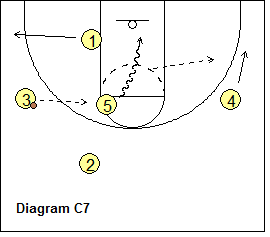

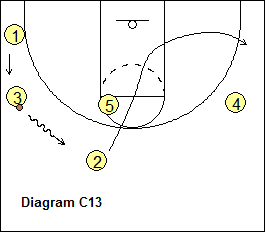
UCLA cut
But in diagram C14 we see that the X4 defender is denying, overplaying the pass to the opposite guard spot O4. Here, O3 passes back to the wing O1. O3 then makes the "UCLA" cut, which is a front-cut, around O5's screen. We make a pass to the wing and a UCLA cut whenever the guard-to-guard pass is denied.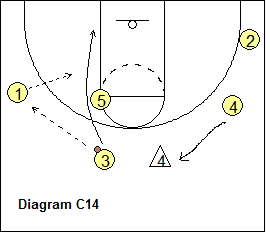

After a UCLA screen, O5 always pops out to the arc to receive the pass from the guard O1 (diagram C15). O5 could look inside to O3 posting up, if there is a mis-match inside. If the reverse pass to the right guard spot O4 is denied, O4 cuts back-door and then the pass to O2 rotating up will be open (diagram C16). After passing, O5 downscreens for O3, the UCLA cutter. O3 cuts hard around the downscreen and could get the pass from O2 for an open 3-point shot (diagram C17).
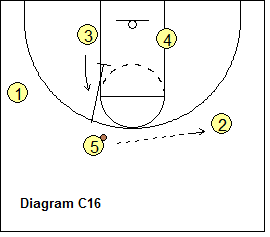
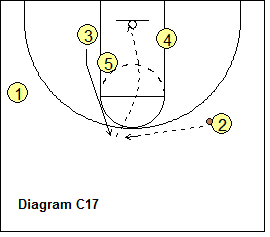
Get the rest of the Princeton "Chin" Series in the Premium Members section and the Playbook download. Sign up now!
It also includes all of these important parts of the Princeton "Chin" Series:
- Danger points in "Chin".
- Going from Chin to UCLA to Low-Post Play.
Final Thoughts from Pete Carril
There is a lot to learn with the three basic "sets" - the "Low Post Offense", "High-Post Offense", and the "Chin Series". You want to use just parts of this offense. A coach should design his offense based on his team's personnel. If you have a strong big man, use the low-post offense - if not, use the high-post offense or "chin" series.In your first week of practice, have your players scrimmage a lot and you'll soon get a feeling for what you have, and who can do what. Then you can design your offense for this group of players. Coach Carril also says, "it doesn't matter what offense you use if your players play together."... and understand their roles within the offense. You don't want poor shooters taking the outside shots.
Related pages:
- 7 Basic Actions of the Princeton Offense
- Princeton Offense
- Princeton Offense Plays
- Muffet McGraw's Princeton Shooting Drills
Get the DVDs! Understanding the Princeton offense is like understanding the overall concept of "offense" itself, as much of this offense's fundamentals apply to any offense. All good coaches know something about the Princeton offense, and if you plan on using this offense, you must get Coach Carril's 2-DVD set. The second DVD includes many breakdown drills for teaching the offense.

"Princeton Offense" with Pete Carril
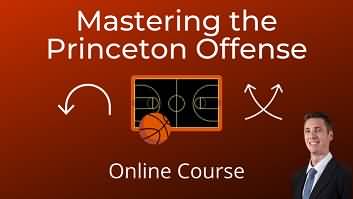
Coach Quinn McDowell has an excellent new online program, "Mastering the Princeton Offense". Any coach serious about the Princeton offense should sign up for this course. It includes a 47 page pdf that details and diagrams all the actions, quick hitters, drills, terminology, etc. There are many video clips including whiteboard discussions with Coach McDowell, and game video clips - film study - of teams running the offense.

"Princeton Offense" with Pete Carril

Coach Quinn McDowell has an excellent new online program, "Mastering the Princeton Offense". Any coach serious about the Princeton offense should sign up for this course. It includes a 47 page pdf that details and diagrams all the actions, quick hitters, drills, terminology, etc. There are many video clips including whiteboard discussions with Coach McDowell, and game video clips - film study - of teams running the offense.



